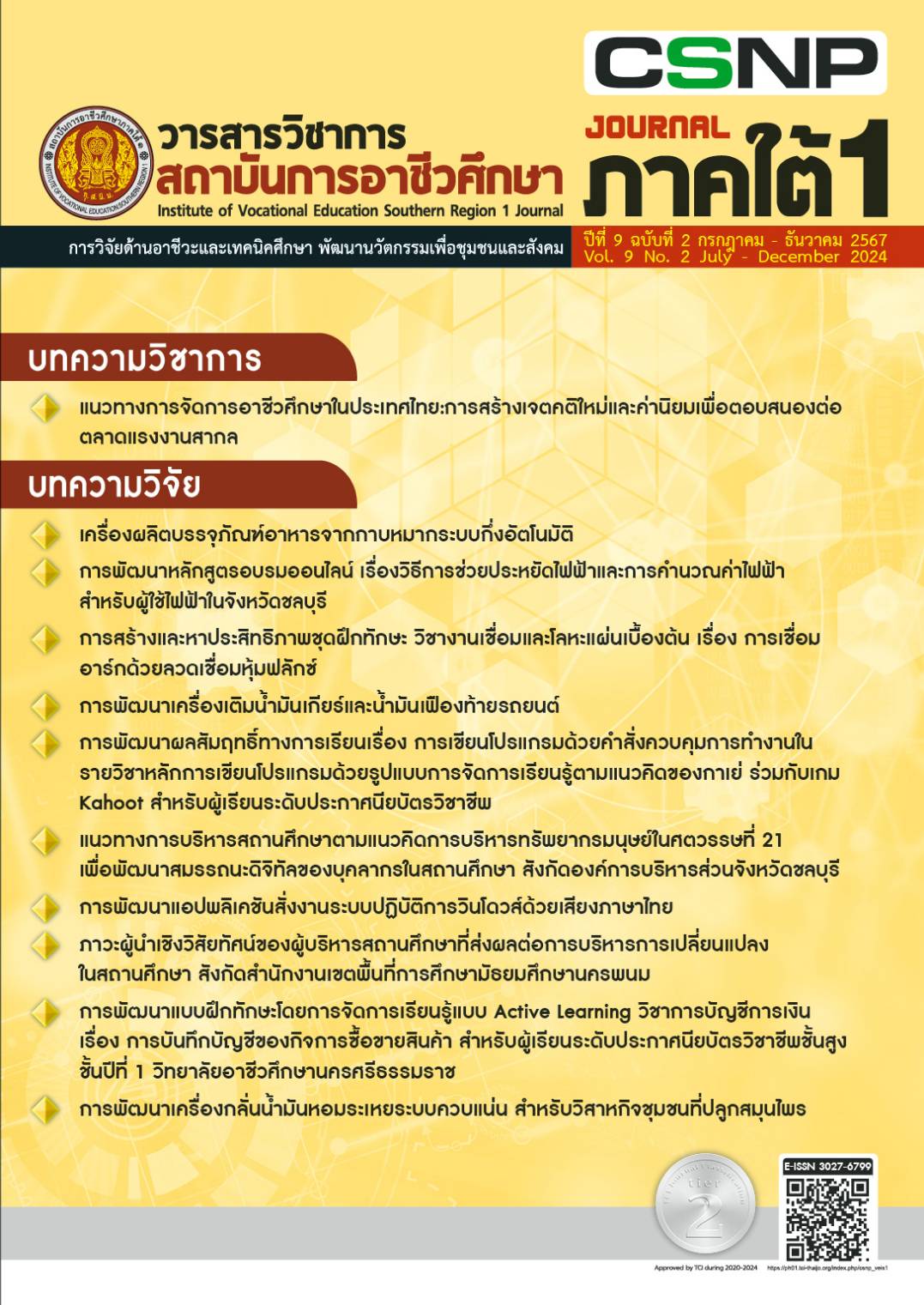Guidelines for Vocational Education Management in Thailand: Creating New Attitudes and Values to Meet Global Labor Market Demands
Keywords:
Vocational Education Management, Human Capital, Attitudes and Values, Global Labor MarketAbstract
This article aims to explore aspects of vocational education that have been socially stigmatized; thus, contributing to a preference for general education over vocational tracks. This bias has resulted in an insufficient skilled workforce required by the industry. Additionally, vocational institutions are often unprepared in terms of curriculum, teaching methods, and technology, which do not align with industrial advancements; thereby, creating a skill gap between existing workers and market needs. This paper proposes methods to elevate vocational education to a global standard, starting with instilling new attitudes and creating positive social values. By doing so, all stakeholders can recognize the critical role of vocational education's human capital in advancing the industrial sector. Viewing vocational students as valuable human capital can drive economic systems through concerted efforts across society, educational institutions, and businesses, ultimately helping Thailand escape the middle-income trap and adapt to changes.
References
Corce, G., & Ghignoni, E. (2012). Demand and Supply of Skilled Labour and Overeducation in Europe: A Country-level Analysis. Comparative Economic Studies, 54(2), 1-24.
Hassan, A., Dutta, P. K., Gupta, S., Mattar, E., & Singh, S. (2024). Emerging Technologies in Digital Manufacturing and Smart Factories. Hershey PA: IGI Global.
พัชรพร ลีพิพัฒน์ไพบูลย์ และนันทนิตย์ ทองศรี. (2561). หุ่นยนต์ในภาคอุตสาหกรรม: กระแสใหม่ที่แรงงานต้องกังวลจริงหรือ. กรุงเทพมหานคร: ธนาคารแห่งประเทศไทย.
Peprah, W. K., & Anowuo, I. (2019). Human Capital Development and Organizational Performance: A Conceptual Review. International Journal of Innovative Research and Development, 8(1), 49-54.
Orlova, E. V. (2021). Design of Personal Trajectories for Employees’ Professional Development in the Knowledge Society under Industry 5.0. Social Sciences, 10(11), 1-29.
Al-Asfour, A., Rajasekar, J., & Mashrafi, A. A. (2020). Fostering Organisational Dynamic by Promoting Creativity of Employees in the Public Sector. International Journal of Innovation, Creativity and Change, 12(7), 150-172.
Kiran, V. S., Shanmugam, V., Raju, R. K., & Kanagasabapathy, J. R. (2022). Impact of Human Capital Management on Organizational Performance with the Mediation Effect of Human Resource Analytics. International Journal of Professional Business Review, 7(3), 1-27.
Boroujerdi, R. Y., Siadat, A., Hoveida, R., & Khani, S. (2014). The Study of the Nature of Human Capital Management and Its Strategic Role in Achieving of Competitive Advantage for the Organization. International Journal of Scientific and Research Publications, 4(5), 1-4.
Nelson, R. E. (2004). The Strength of Strong Ties: Social Networks and Intergroup Conflict in Organizations. Academy of Management Journal, 32(2), 377-401.
ณัฐสิฏ รักษ์เกียรติวงศ์. (2558). การปฏิรูปอาชีวศึกษาของประเทศไทย. กรุงเทพมหานคร: สถาบันวิจัยเพื่อการพัฒนาประเทศไทย (ทีดีอาร์ไอ).
สุภาพร ศรีนางแย้ม, องอาจ นัยพัฒน์, และทวิกา ตั้งประภา. (2565). การประเมินความต้องการจำเป็นในการเสริมสร้างนิสัยอุตสาหกรรมของนักศึกษาระดับประกาศนียบัตรวิชาชีพชั้นสูงระบทวิภาคี เขตระเบียงเศรษฐกิจพิเศษภาคตะวันออก. วารสารสังคมศาสตร์และมานุษยวิทยาเชิงพุทธ, 7(7), 315-328.
Gungor, G. (2020). Problems and Solution Suggestions Encountered in Vocational Skill Training in Vocational High School: Teachers’ Views. European Journal of Education Studies, 7(4), 233-253.
CEDEFOP. (2011). The Benefits of Vocational Education and Training. Luxembourg: Publications Office of the European Union.
Petty, R., & Brinol, P. (2014). Emotion and Persuasion: Cognitive and Meta-Cognitive Processes Impact Attitudes. Cognition and Emotion, 29(1), 1-26.
Hovland, C. I., & Janis, I. L. (1959). Personality and persuasibility. New Haven, CT: Yale University Press.
Chalapati, N., & Chalapati, S. (2020). Building a skilled workforce: Public discourses on vocational education in Thailand. International Journal for Research in Vocational Education and Training, 7(1), 67-90.
สำนักงานคณะกรรมการวัฒนธรรมแห่งชาติ. (2559). ค่านิยม และสภาพแวดล้อมที่พึงประสงค์ของสังคมไทยในสายตาเยาวชน. กรุงเทพมหานคร: คุรุสภาลาดพร้าว.
สำนักงานคณะกรรมการการอาชีวศึกษา. (2555). นโยบาย เป้าหมาย ยุทธศาสตร์ การผลิตและพัฒนากำลังคนอาชีวศึกษาสู่สากล พ.ศ. 2555-2569. กรุงเทพมหานคร: สำนักงาน.
สำนักงานเลขาธิการสภาการศึกษา. (2559). โครงการศึกษาเพื่อทบทวนความต้องการกำลังคนเพื่อใช้วางแผนการผลิตและพัฒนาทรัพยากรมนุษย์ของประเทศ. กรุงเทพมหานคร: พริกหวานกราฟฟิค.
เกียรติอนันต์ ล้วนแก้ว. (2561). [ออนไลน์] ช่องว่างทักษะกับนัยยะที่มีต่อการพัฒนากำลังคนของประเทศไทย. [สืบค้นเมื่อวันที่ 20 เมษายน 2567]. จาก http://www.econ.tu.ac.th/symposium40/paper/003_Symposium40.
สำนักงานคณะกรรมการการอาชีวศึกษา. (2557). แนวทางปฏิบัติการจัดการอาชีวศึกษาระบบทวิภาคีตามประกาศกระทรวงศึกษาธิการ เรื่อง มาตรฐานการจัดการอาชีวศึกษาระบบทวิภาคี พ.ศ. 2557. กรุงเทพมหานคร: ศูนย์อาชีวศึกษาทวิภาคี.
Bratianu, C. (2015). Organizational Learning and the Learning Organization. Hershey: IGI Global.
Downloads
Published
Issue
Section
License
Copyright (c) 2024 Institute of Vocational Education Southern Region 1 Journal

This work is licensed under a Creative Commons Attribution-NonCommercial-NoDerivatives 4.0 International License.



